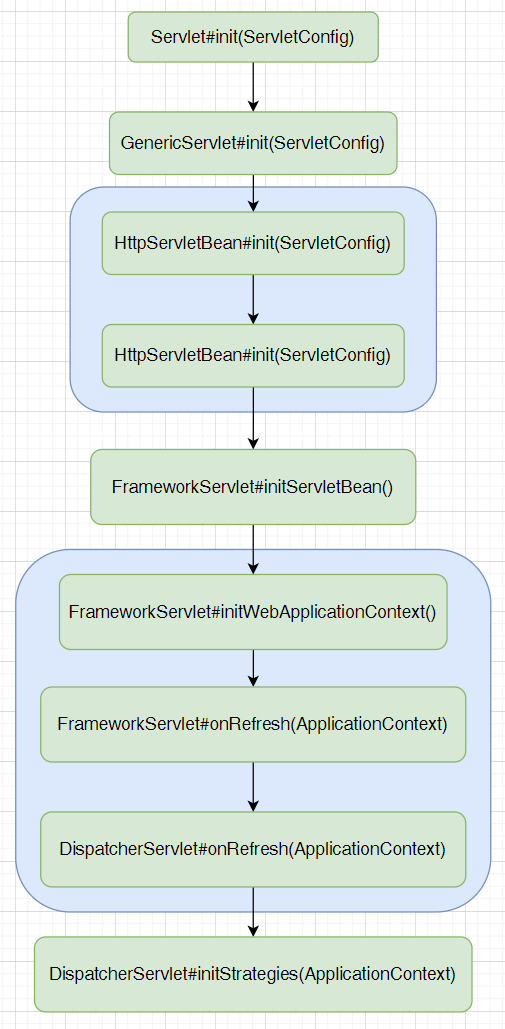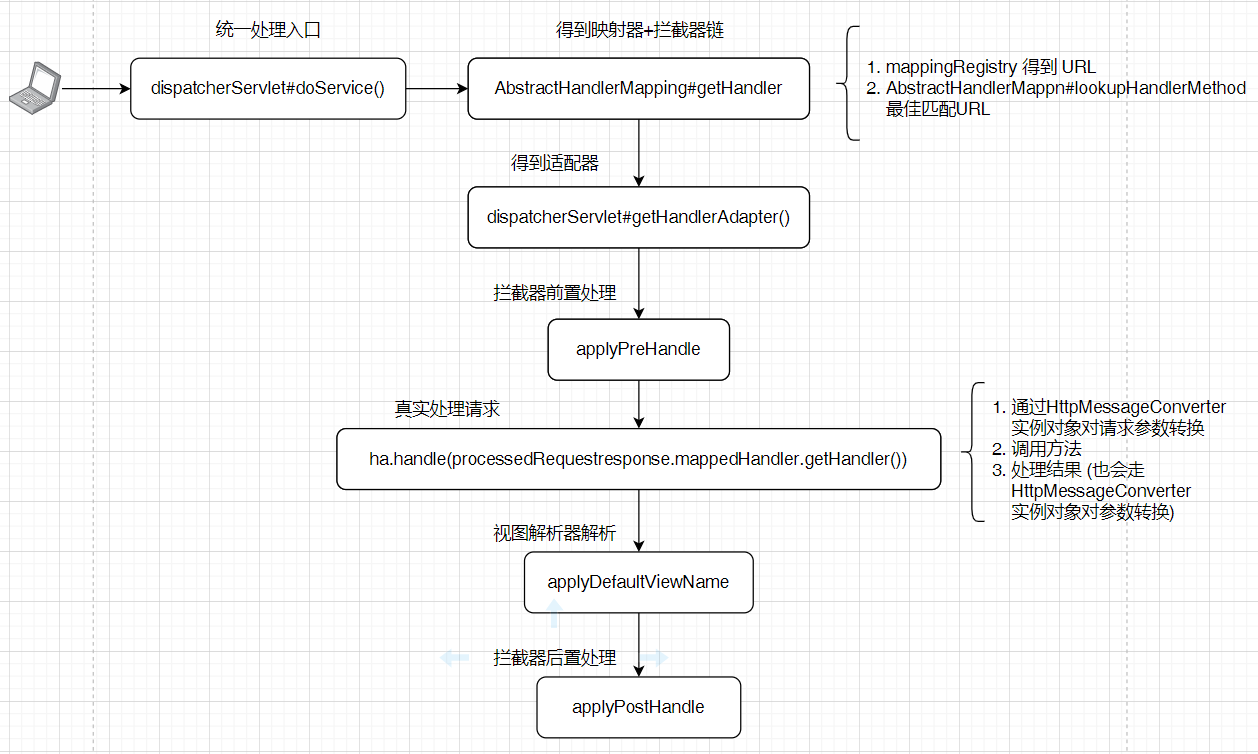Spring MVC 之 DispatchServlet
DispatchServlet 源码分析
首先我们看看 DispatcherServlet 的类结构,可以清楚地发现实际 DispatcherServlet 就是 Servlet 接口的一个子类。

DispatchServlet 初始化
既然最顶层是 Servlet,那么初始化入口肯定是Servlet#init(ServletConfig)方法,沿着这个思路去看源码,可以得大体框架图:

HttpServletBean#init
@Override
public final void init() throws ServletException {
// Set bean properties from init parameters.
// 解析web.xml中init-param标签,存储到PropertyValues
PropertyValues pvs = new ServletConfigPropertyValues(getServletConfig(), this.requiredProperties);
if (!pvs.isEmpty()) {//通过xml方式配置springmvc,会进入这个if。如果是注解方式则不进入
try {
//这里的this指向的DispatcherServlet,下面的代码是给DispatcherServlet中contextLocation属性赋值
BeanWrapper bw = PropertyAccessorFactory.forBeanPropertyAccess(this);
ResourceLoader resourceLoader = new ServletContextResourceLoader(getServletContext());
bw.registerCustomEditor(Resource.class, new ResourceEditor(resourceLoader, getEnvironment()));
initBeanWrapper(bw);
bw.setPropertyValues(pvs, true); //赋值操作
}
catch (BeansException ex) {
if (logger.isErrorEnabled()) {
logger.error("Failed to set bean properties on servlet '" + getServletName() + "'", ex);
}
throw ex;
}
}
// Let subclasses do whatever initialization they like.
initServletBean(); //子类实现
}
这段代码就是保存springmvc配置的,基于 xml 方式配置 springmvc,会进入 if 分支。PropertyValues 是一个键值对,内容就是 xml 配置 init-param 标签,key=contextConfigLocation,value=classpath:springmvc04.xml。
FrameworkServlet#initServletBean
这个方法大部分都是日志检查,最核心方法就是initWebApplicationContext,初始化IOC容器。initFrameworkServlet目前是空方法。
protected final void initServletBean() throws ServletException {
getServletContext().log("Initializing Spring " + getClass().getSimpleName() + " '" + getServletName() + "'");
if (logger.isInfoEnabled()) {
logger.info("Initializing Servlet '" + getServletName() + "'");
}
long startTime = System.currentTimeMillis();
try {
//初始化IOC容器 ApplicationContext
this.webApplicationContext = initWebApplicationContext();
initFrameworkServlet(); // 这方法是空
}
catch (ServletException | RuntimeException ex) {
logger.error("Context initialization failed", ex);
throw ex;
}
if (logger.isDebugEnabled()) {
String value = this.enableLoggingRequestDetails ?
"shown which may lead to unsafe logging of potentially sensitive data" :
"masked to prevent unsafe logging of potentially sensitive data";
logger.debug("enableLoggingRequestDetails='" + this.enableLoggingRequestDetails +
"': request parameters and headers will be " + value);
}
if (logger.isInfoEnabled()) {
logger.info("Completed initialization in " + (System.currentTimeMillis() - startTime) + " ms");
}
}
protected WebApplicationContext initWebApplicationContext() {
WebApplicationContext rootContext =
WebApplicationContextUtils.getWebApplicationContext(getServletContext());
WebApplicationContext wac = null;
//如果是注解方式的springmvc进入if分支,xml方式不进入
if (this.webApplicationContext != null) {
// A context instance was injected at construction time -> use it
wac = this.webApplicationContext;
if (wac instanceof ConfigurableWebApplicationContext) {
ConfigurableWebApplicationContext cwac = (ConfigurableWebApplicationContext) wac;
if (!cwac.isActive()) {
// The context has not yet been refreshed -> provide services such as
// setting the parent context, setting the application context id, etc
if (cwac.getParent() == null) {
// The context instance was injected without an explicit parent -> set
// the root application context (if any; may be null) as the parent
cwac.setParent(rootContext);
}
configureAndRefreshWebApplicationContext(cwac);
}
}
}
if (wac == null) {
// No context instance was injected at construction time -> see if one
// has been registered in the servlet context. If one exists, it is assumed
// that the parent context (if any) has already been set and that the
// user has performed any initialization such as setting the context id
wac = findWebApplicationContext();
}
if (wac == null) {
// No context instance is defined for this servlet -> create a local one
wac = createWebApplicationContext(rootContext); //这里创建ioc容器
}
//spring异步事件,在创建ioc容器时会产生一个异步事件,去刷新ioc容器
//这里简单起见,假设没有接收到事件,刷新操作会在当前线程完成
if (!this.refreshEventReceived) {
// Either the context is not a ConfigurableApplicationContext with refresh
// support or the context injected at construction time had already been
// refreshed -> trigger initial onRefresh manually here.
synchronized (this.onRefreshMonitor) {
onRefresh(wac);
}
}
//到这里只需要设置属性即可
if (this.publishContext) {
// Publish the context as a servlet context attribute.
String attrName = getServletContextAttributeName();
getServletContext().setAttribute(attrName, wac);
}
return wac;
}
DispatcherServlet#onRefresh
本质是初始化各种解析器
/**
* This implementation calls {@link #initStrategies}.
*/
@Override
protected void onRefresh(ApplicationContext context) {
initStrategies(context);
}
/**
* Initialize the strategy objects that this servlet uses.
* <p>May be overridden in subclasses in order to initialize further strategy objects.
*/
protected void initStrategies(ApplicationContext context) {
initMultipartResolver(context); //初始化文件上传解析器
initLocaleResolver(context); //初始化本地域解析器
initThemeResolver(context);
initHandlerMappings(context); //初始化处理器映射
initHandlerAdapters(context);
initHandlerExceptionResolvers(context); //异常解析器
initRequestToViewNameTranslator(context);
initViewResolvers(context); //视图解析器
initFlashMapManager(context);
}
DispatchServlet 处理流程
DispatcherServlet 类上可以看到很多熟悉的成员变量(组件),所以看下来,我们要的东西,DispatcherServlet 可全都有。
// 文件处理器
private MultipartResolver multipartResolver;
// 映射器
private List<HandlerMapping> handlerMappings;
// 适配器
private List<HandlerAdapter> handlerAdapters;
// 异常处理器
private List<HandlerExceptionResolver> handlerExceptionResolvers;
// 视图解析器
private List<ViewResolver> viewResolvers;
它们在initStrategies()上初始化。
请求进到 DispatcherServlet,其实全部都会打到 doService() 方法上。我们看看这个doService()方法做了啥:
protected void doService(HttpServletRequest request, HttpServletResponse response) throws Exception {
// 设置一些上下文...(省略一大部分)
request.setAttribute(OUTPUT_FLASH_MAP_ATTRIBUTE, new FlashMap());
request.setAttribute(FLASH_MAP_MANAGER_ATTRIBUTE, this.flashMapManager);
try {
// 调用doDispatch
doDispatch(request, response);
}
finally {
if (!WebAsyncUtils.getAsyncManager(request).isConcurrentHandlingStarted()) {
if (attributesSnapshot != null) {
restoreAttributesAfterInclude(request, attributesSnapshot);
}
}
}
}
所以请求会走到 doDispatch(request, response); 里边,我们再进去看看:
@SuppressWarnings("deprecation")
protected void doDispatch(HttpServletRequest request, HttpServletResponse response) throws Exception {
HttpServletRequest processedRequest = request;
HandlerExecutionChain mappedHandler = null;
boolean multipartRequestParsed = false;
WebAsyncManager asyncManager = WebAsyncUtils.getAsyncManager(request);
try {
ModelAndView mv = null;
Exception dispatchException = null;
try {
// 检查是不是文件上传 multipart 请求
processedRequest = checkMultipart(request);
multipartRequestParsed = (processedRequest != request);
// Determine handler for the current request. 获取处理器映射器,找到HandlerExecutionChain
mappedHandler = getHandler(processedRequest);
if (mappedHandler == null) {
//没有找到映射器处理器 则报404 not found
noHandlerFound(processedRequest, response);
return;
}
// Determine handler adapter for the current request. 获取处理器适配器,通常是RequestMappingHandlerAdapter
HandlerAdapter ha = getHandlerAdapter(mappedHandler.getHandler());
// Process last-modified header, if supported by the handler.
String method = request.getMethod();
boolean isGet = HttpMethod.GET.matches(method);
if (isGet || HttpMethod.HEAD.matches(method)) { //判断是否为GET、HEAD请求
long lastModified = ha.getLastModified(request, mappedHandler.getHandler());
if (new ServletWebRequest(request, response).checkNotModified(lastModified) && isGet) {
return;
}
}
//拦截前置处理,preHandle方法
if (!mappedHandler.applyPreHandle(processedRequest, response)) {
return;
}
// Actually invoke the handler.
// 处理器适配器,执行真正处理方法,在内部创建 ModelAndView 对象
// 可能调用到 AbstractHandlerMethodAdapter 中的 handle 方法
mv = ha.handle(processedRequest, response, mappedHandler.getHandler());
if (asyncManager.isConcurrentHandlingStarted()) {
return;
}
// 设置ModelAndView 中视图名称
applyDefaultViewName(processedRequest, mv);
// 拦截器后置处理,postHandle方法
mappedHandler.applyPostHandle(processedRequest, response, mv);
}
catch (Exception ex) {
dispatchException = ex;
}
catch (Throwable err) {
// As of 4.3, we're processing Errors thrown from handler methods as well,
// making them available for @ExceptionHandler methods and other scenarios.
dispatchException = new NestedServletException("Handler dispatch failed", err);
}
//渲染视图
processDispatchResult(processedRequest, response, mappedHandler, mv, dispatchException);
}
catch (Exception ex) {
triggerAfterCompletion(processedRequest, response, mappedHandler, ex);
}
catch (Throwable err) {
triggerAfterCompletion(processedRequest, response, mappedHandler,
new NestedServletException("Handler processing failed", err));
}
finally {
if (asyncManager.isConcurrentHandlingStarted()) {
// Instead of postHandle and afterCompletion
if (mappedHandler != null) {
mappedHandler.applyAfterConcurrentHandlingStarted(processedRequest, response);
}
}
else {
// Clean up any resources used by a multipart request.
if (multipartRequestParsed) {
cleanupMultipart(processedRequest);
}
}
}
}
从源码可以知道的是,原来 SpringMVC 的拦截器是在 MappingHandler 的时候一齐返回的,返回的是一个HandlerExecutionChain 对象:
public class HandlerExecutionChain {
private static final Log logger = LogFactory.getLog(HandlerExecutionChain.class);
// 真实的handler
private final Object handler;
// 拦截器List
private HandlerInterceptor[] interceptors;
private List<HandlerInterceptor> interceptorList;
private int interceptorIndex = -1;
}
OK,整体的流程我们是已经看完了。
更详细流程参考:https://mp.weixin.qq.com/s/BO_CPQ0x-kBMIYBOviG3Xg
流程图如下:
